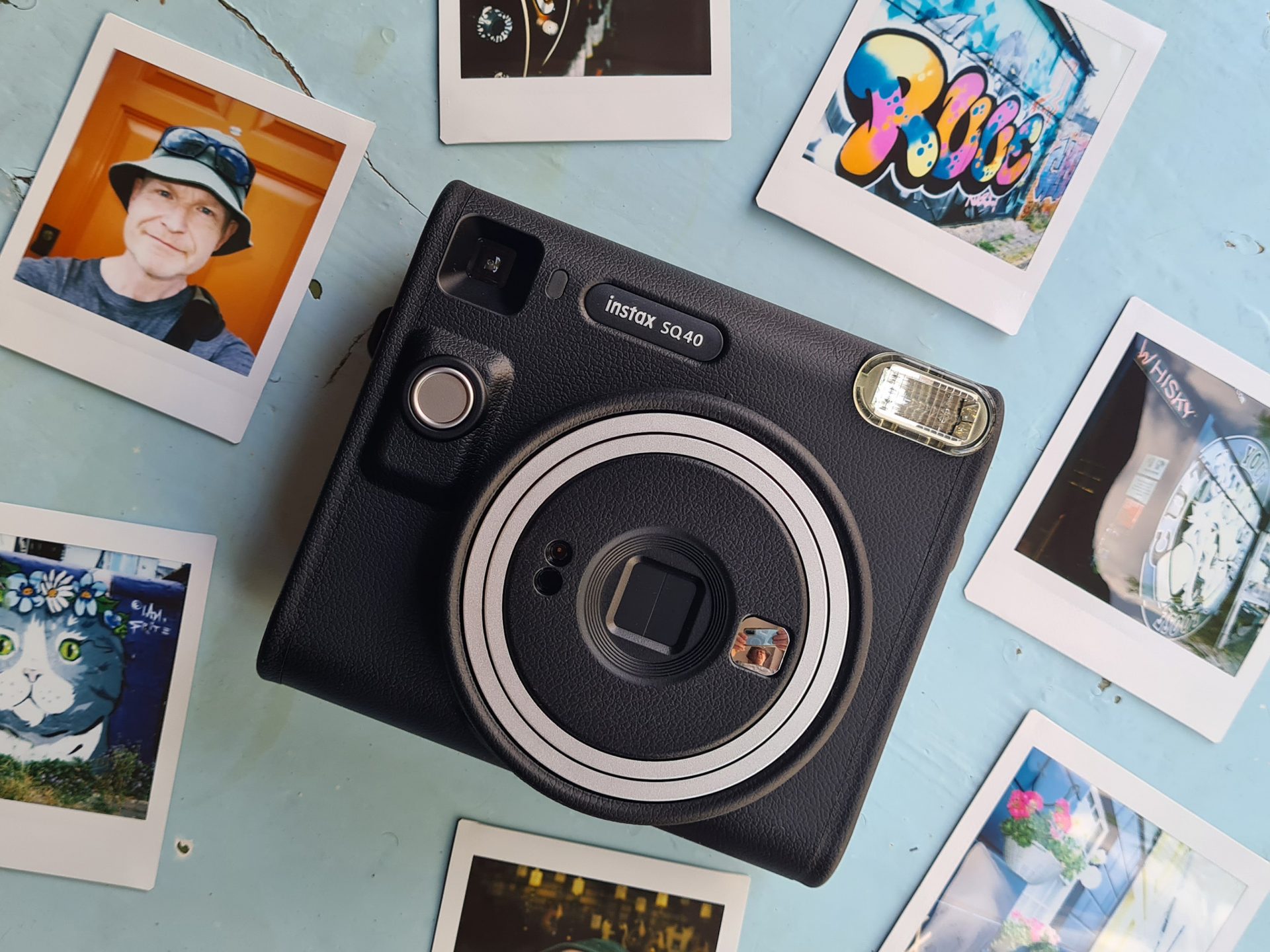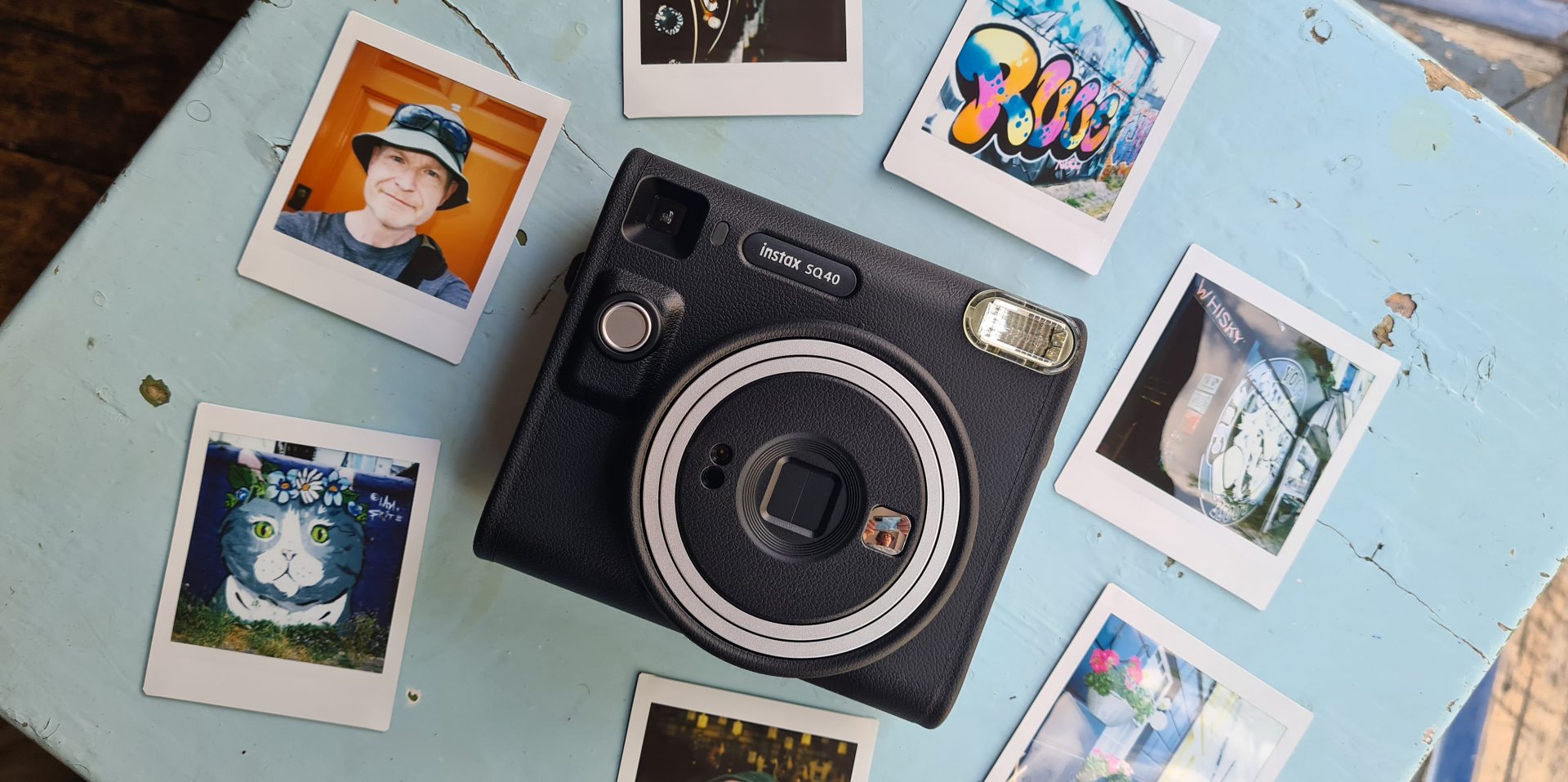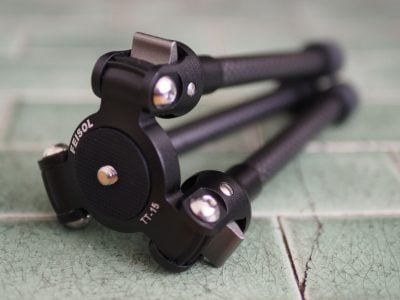Fujifilm instax SQ40 review
-
-
Written by Gordon Laing
The instax SQ40 is the latest instant camera from Fujifilm to use instax square film. Launched in June 2023 and costing around $150 or £135, the SQ40 produces small prints using a fully analogue process where the paper emerges straight after you take the shot with the image gradually fading into view roughly 90 seconds later.
It’s exactly the same concept as the hugely popular instax Mini cameras, except the SQ models use instax Square cartridges, producing wider square pictures reminiscent of vintage Polaroids, but shrunk-down. It’s my favourite of the three instax print shapes and in the video below I’ll show you what’s new and how it compares to other models. If you prefer to read a written version, keep scrolling!
Each instax square cartridge contains ten prints, with twin packs generally representing the best value at around 18 dollars or pounds – so that works out roughly 90 cents or pence per print – only a little more than Mini film and for my money, way nicer to look at. Like the Mini versions, Fujifilm also sells square film with different coloured borders – but remember each instax camera is only designed for one print shape, so you can’t load Mini carts into a Square camera or vice versa.
The SQ40 box contains the camera, a neck strap, instruction manual and a pair of disposable CR2 Lithium batteries to power it – these should be good for up to 30 carts, or 300 prints. Depending where you buy it, the camera may include one film cartridge to get you started.
Like many new instax cameras, the SQ40 is based on an existing model, in this case the SQ1 launched roughly three years earlier and still on sale in the choice of three colours for around $120 or pounds.
Place them side by side and you’ll notice the functional parts, like the lens, viewfinder, flash and shutter buttons are all in the same places, confirming the SQ40 on the right is simply the SQ1 with a different finish. Same features, same photo quality, but more serious looks for those who find the SQ1 on the left a little frivolous.
Fujifilm’s done this before with the Mini 11 and Mini 40, which explains the naming of the new SQ40. The Mini 11 and Mini 40 again share the same features and print quality, but the 40 sported more of a retro-finish for those who wanted an instant camera, but weren’t fond of chunky bodies and pastel colours.
So SQ40 is not a follow-up to the earlier SQ10 and SQ20 models which employed digital sensors and screens. Instead, 40 in the instax lineup now refers to an analogue camera with a vintage retro look and feel, which means maybe we’ll see a Wide 40 in the future. C’mon Fujifilm, it’s time for a new Wide camera, can I get an Amen in here?
Before moving on though, it’s important to note while the SQ40 shares similar styling to the Mini 40 before it and is only available in black with silver details, the actual finish is much nicer in your hands. Less plasticky and more rubbery, giving it a higher quality not to mention grippier look and feel. It’s much classier in person.
And while the innards are identical to the SQ1, Fujifilm has made some minor adjustments to the SQ40’s grip, shaving off much of the SQ1’s rounded front, leaving the shutter button perched on a smaller plateau. In my hands, this made the SQ40 more comfortable, avoiding the tight pinch between the grip and lens barrel on the SQ1, while on the rear, the rubbery surface felt less slippy under my thumb. But beyond these exterior tweaks, the SQ40 is essentially the same as the SQ1.
This means it’s very simple to use. Round the back you’ll find a large door for loading film, although do check the window first for a yellow mark which means you’ve already got a cartridge loaded; if you do, a counter towards the bottom right will tell you how many shots you have left. If the counter indicates 0 you’re out of shots, and if it shows S, there’s no cartridge loaded at all. Either way, you’re safe to open the door and load a new cartridge – just align the yellow mark on the cartridge with the one on the camera, push it inside, then close the door. Next switch on the camera by twisting the large circular lens barrel which also extends the lens for use. Before you can take any photos, you’ll first need to eject the initial safety sheet, so just push the shutter button and it’ll pop out; you can throw this away. Now the counter on the rear will indicate you have ten shots remaining and you’re good to go.
Again like the fully-analogue instax models before it, composition is with a small optical viewfinder when you’re behind the camera, or a tiny mirror to the right of the lens when you’re in front of it taking a selfie.
Like the SQ1 before it, beware of framing as you get closer to your subject, as the viewfinder will become less accurate due to parallax. In both of these shots, the donut sculpture on the left and the coffee cup on the right were placed in the middle of the viewfinder. The former has come out how I expected as it was a few meters away, but the coffee is well off-centre as it was shot at much closer range, so be warned. But hey, not quite knowing what you’re going to get is all part of the analogue charm, right?
The only adjustable control on the camera is the twistable lens ring with two positions depending on focusing distance: the first twist powers-on the camera and focuses it on subjects beyond half a meter, while twisting it further to the selfie position refocuses the lens to between 30 and 50cm. When you’re done, just twist it all the way back again to retract the lens and power it off. Beyond that, the SQ40 is fully automatic with no manual control over exposure or the flash which fires on every shot like the SQ1 and most of the Minis.
Ok, here’s some shots I took with the SQ40. The simple lens delivers mild wide-angle coverage that’s suitable for general-use from portraits and selfies to buildings and landscapes. Exposure is again automatic with the camera able to access shutter speeds from half to 400th of a second that, with the fixed aperture and film sensitivity, should cover you from fairly bright scenes to dim interiors. As before, selfies in medium light seem to work best of all, and I was pleased to find my pasty skin tones not becoming washed-out.
Very bright scenes are however still likely to over-expose with washed-out skies becoming a familiar sight on all the analogue instax cameras I’ve tested. But at least the SQ40 remains an improvement over the Mini 11 and 12 which have a fastest shutter speed of 1/250 and especially the Mini 9s and earlier models which stopped at 1/60 and over-exposed in even mild brightness. That said, I still think Fujifilm should boost the top shutter speed to 1/500 or maybe faster still on future models to better cope with very bright conditions – after all, surely many instax cameras are taken on Sunny holidays.
Meanwhile at the other end of the scale, access to longer shutter speeds allows the SQ40 to capture more of the surroundings in dim interiors.
That said, don’t expect miracles. When it’s too dim, or the subject is beyond the flash range, you’ll end up with muddy images, and again at the other end of the scale, expect over-exposures on light-coloured subjects during bright days. The trick, as with all analogue INSTAX cameras, is to learn what kind of subjects and conditions will produce the best results and just forget about others as you’ll inevitably waste your prints.
That’s not to say the instax process can’t make great-looking prints of very bright or very dark scenes, but you’re unlikely to be using an instax analogue camera to take them.
If you love the instax format but are happy to trade the immediacy, surprise and ephemeral nature of the cameras for something more predictable, you could simply buy an instax Link printer, available for Mini, Square or Wide versions which will connect to your phone and print anything you have on it. This could include photos transferred from a high-end camera, allowing you to make instax prints of subjects taken under a much wider variety of conditions with ultra wide or long lenses, extreme macros, blurry backgrounds and more.
And that’s one of the two main decisions you have to make when choosing an instax product. First decide on the format, Mini, Square or Wide, as again the cameras and printers can’t mix cartridges. Second, decide if you want the surprise, fun and simplicity of an analogue camera, or the predictability of a wireless printer.
There’s also a third option to consider which in theory gives you the best of both Worlds: going for one of Fujifilm’s digital instax cameras, which employ a sensor, built-in memory and screen, allowing you to not only take lots of photos and apply various effects to them, but crucially view them on the screen before deciding whether to print them or not.
In theory this approach sounds like a no-brainer, but I actually find them the least compelling in practice. If I want predictability, I’d prefer a instax printer that’s designed to work with my phone. If I want the fun, the analogue instax models will give me something genuinely different in operation and results to a digital camera. In fact I’d say there’s an argument for having both a wireless printer and an analogue camera.
Fujifilm instax SQ40 verdict
Overall the instax SQ40 is a nice addition to the instax family, bringing the fully-automatic simplicity of the SQ1, but with a more grown-up looking retro-styled finish. But be in no doubt the SQ40 is simply an SQ1 in hipster drag, with both models sharing the same quality and features, which means inheriting the good and the bad. Like the SQ1, it’s a pure point-and-shoot with no control beyond setting the focusing range from near to far, and under very bright or dim conditions, you’ll often suffer from over or underexposed prints.

If you desire an INSTAX Square camera with a little more control, try tracking-down the discontinued instax SQ6 which allows you to lighten or darken the exposure or take double exposures, while having the bonus of looking like a giant Instagram logo. I don’t have their sales figures, but I’m sure there’s some demand for a new analogue instax camera with broader control, maybe in the Wide format? How about it Fujifilm? It’s also worth looking to third party solutions, such as NONS which produces SLRs with interchangeable lenses that use instax film.
Or if you’re more price-conscious, the cheapest analogue instax cameras remain the Minis and my choice in that series is the recent instax Mini 12. But remember once you start buying cartridges, the running costs won’t be hugely different from the Squares.
Meanwhile those who never want a wasted print and like the idea of making instax photos from their larger cameras should get an instax Link printer, again available in any of the three print formats.
Ultimately I love the instax square format, so unsurprisingly enjoyed my results from the SQ40, and unless you adore the pastel-colours of the SQ1, I’d personally spend the small extra for the grippier feel and classier-looking finish. That said, if you find a great deal on the SQ1, it’s well worth considering as it’s essentially the same camera, just with a different finish.
Check prices on the Fujifilm instax SQ40 at Amazon or WEX UK. Alternatively get yourself a copy of my In Camera book, an official Cameralabs T-shirt or mug, or treat me to a coffee! Thanks!
 The SQ40 is an analogue instant camera that uses Fujifilm's instax Square film. It’s based on the SQ1’s innards, but swaps the pastel colours for a more serious vintage-styled look with a grippy rubber finish. Like the SQ1 though, it remains a pure point-and-shoot with no control beyond two focusing ranges, and under very bright or dim conditions, you’ll often suffer from over or underexposed prints. If you desire an instax Square camera with more control, try tracking-down the discontinued instax SQ6, or maybe even splurging on a third party SLR with interchangeable lenses like those from NONS. If you’re more price-conscious, the cheapest analogue instax cameras remain the Minis and my choice in that series is the recent Mini 12. But once you start buying cartridges, the running costs won’t be hugely different from the Squares, so choose the shape you prefer. Meanwhile those who never want a wasted print and like the idea of making instax photos from their larger cameras should get an instax Link printer, available in any of the three print formats. Ultimately I love the instax square format, so enjoyed my results from the SQ40, and unless you adore the pastel-colours of the SQ1, I’d personally spend the small extra for the grippier feel and classier-looking finish. That said, if you find a great deal on the SQ1, it’s well worth considering as it’s essentially the same camera, just with a different finish.
The SQ40 is an analogue instant camera that uses Fujifilm's instax Square film. It’s based on the SQ1’s innards, but swaps the pastel colours for a more serious vintage-styled look with a grippy rubber finish. Like the SQ1 though, it remains a pure point-and-shoot with no control beyond two focusing ranges, and under very bright or dim conditions, you’ll often suffer from over or underexposed prints. If you desire an instax Square camera with more control, try tracking-down the discontinued instax SQ6, or maybe even splurging on a third party SLR with interchangeable lenses like those from NONS. If you’re more price-conscious, the cheapest analogue instax cameras remain the Minis and my choice in that series is the recent Mini 12. But once you start buying cartridges, the running costs won’t be hugely different from the Squares, so choose the shape you prefer. Meanwhile those who never want a wasted print and like the idea of making instax photos from their larger cameras should get an instax Link printer, available in any of the three print formats. Ultimately I love the instax square format, so enjoyed my results from the SQ40, and unless you adore the pastel-colours of the SQ1, I’d personally spend the small extra for the grippier feel and classier-looking finish. That said, if you find a great deal on the SQ1, it’s well worth considering as it’s essentially the same camera, just with a different finish.



